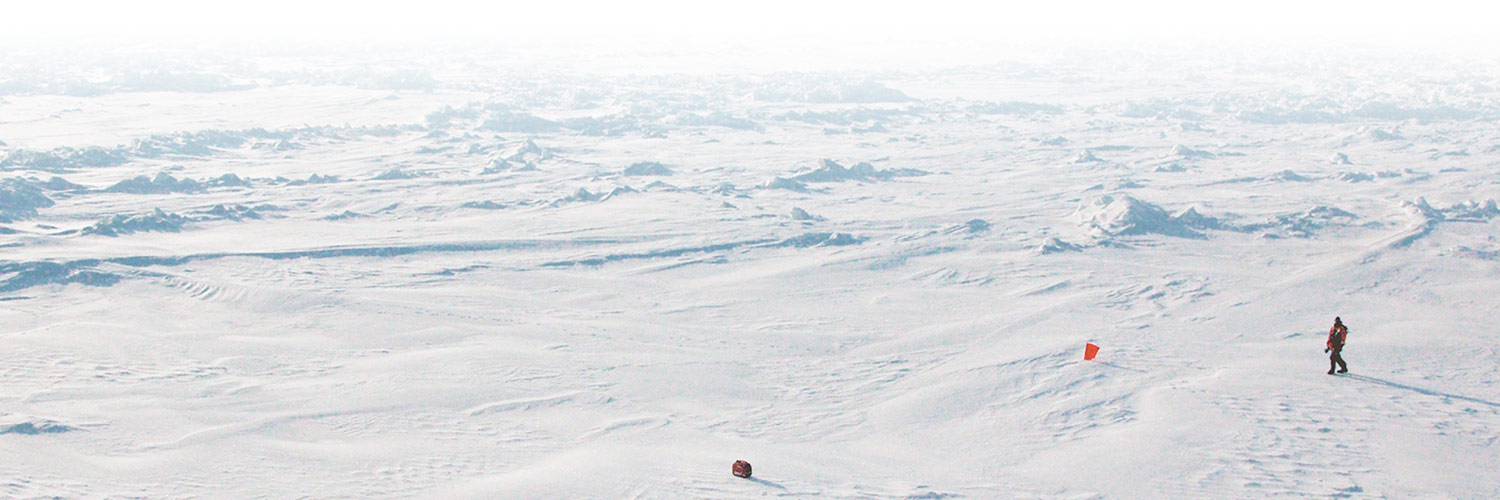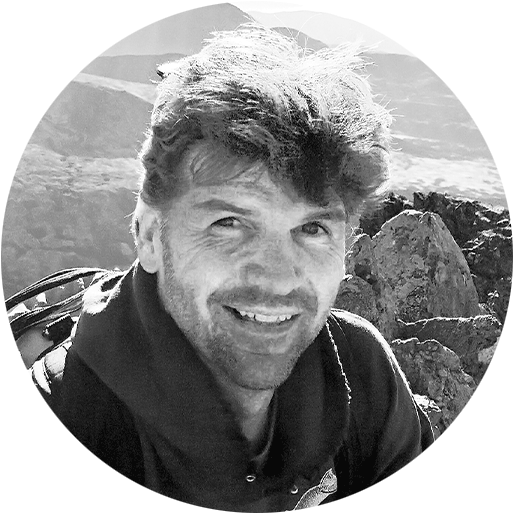step up to the podium in the small lecture theater and look over 120 people assembled from more than a dozen nations. To my right, I see tabular icebergs passing by beyond the oval-shaped windows. My challenge will be to keep the audience focused on my talk rather than the breathtaking nature beyond the ship’s steel hull. The amazing scenery and wildlife are what they are here for, after all, but they are also here to be immersed in nature, to learn and experience, not just to observe. The date is December 21, 2006, and I am giving a lecture on climate change aboard the MS Nordnorge while cruising along the west side of the Antarctic Peninsula.
There was some anticipation about this talk, especially for the North Americans in the audience. George W. Bush was president of the United States, and it was a few months prior to the release of the Intergovernmental Panel on Climate Change (IPCC), which would ultimately change his official stance on the reality of man-made climate change.
After my presentation and a constructive discussion, a woman approached to thank me. I politely accepted her compliment but was somewhat bewildered until she explained; the thanks were for publicly explaining and speaking out about climate change, something she, as a U.S. federal employee, was not allowed to do prior to the 2007 IPCC Report.
 Learn more about climate change: stantec.com/en/services/sustainability/climate-change-design-technology
Learn more about climate change: stantec.com/en/services/sustainability/climate-change-design-technologystep up to the podium in the small lecture theater and look over 120 people assembled from more than a dozen nations. To my right, I see tabular icebergs passing by beyond the oval-shaped windows. My challenge will be to keep the audience focused on my talk rather than the breathtaking nature beyond the ship’s steel hull. The amazing scenery and wildlife are what they are here for, after all, but they are also here to be immersed in nature, to learn and experience, not just to observe. The date is December 21, 2006, and I am giving a lecture on climate change aboard the MS Nordnorge while cruising along the west side of the Antarctic Peninsula.
There was some anticipation about this talk, especially for the North Americans in the audience. George W. Bush was president of the United States, and it was a few months prior to the release of the Intergovernmental Panel on Climate Change (IPCC), which would ultimately change his official stance on the reality of man-made climate change.
After my presentation and a constructive discussion, a woman approached to thank me. I politely accepted her compliment but was somewhat bewildered until she explained; the thanks were for publicly explaining and speaking out about climate change, something she, as a U.S. federal employee, was not allowed to do prior to the 2007 IPCC Report.
In some respects, we have come a long way since those days. In other ways, we have not.
I see a climate change related story or report in the media almost daily now, usually another weather-related record that has been broken, affecting people’s daily lives. Global business strategies and investments are increasingly and explicitly considering climate change related risks. The World Economic Forum has identified climate change in three of their top five risks to the global economy, and almost 70 percent of adults in the U.S. (92 percent in Europe and 94 percent in China) agree that global warming is happening. Scientists have unequivocally demonstrated the link between the burning of fossil fuels, the increase in greenhouse gas concentrations in the atmosphere, and many social, economic and environmental consequences. These include local, regional and global increases in temperatures; the melting of glaciers and sea ice; occurrences of extreme weather events and weather variability; habitat degradation; biodiversity loss; disease; infrastructure damage; social unrest; and decreased food security and public health.
We know that addressing climate change will mitigate many of these issues and increase the resiliency of our socio-ecological system, as well as quality of life for our children and grandchildren. Importantly, acting on climate change has the potential to bring our communities together, focused on a better future for us all. I have seen this firsthand, from coming together over sustainable gardening and recycling initiatives in Swiss communities, to addressing coastal erosion in Alaska’s coastal Arctic communities, to helping implement renewable energy projects on the U.S. east coast.
Unfortunately, our collective efforts do not seem to reflect our knowledge—and our actions fall short. If the awareness of climate change is there, and we understand many of the linkages and consequences, why do global greenhouse gas emissions continue to rise at rates that have us tracking on or near the high-emission scenario climate projection trajectory (RCP 8.5)? Why is it that current policies are projected to fall far short of preventing global average temperature increases above the Paris Accord’s agreed maximum of 1.5oC or even below 2oC?1 While we fail to act commensurate to the scale of the climate crisis, the impact of the shortfall will be a minimum of $2 billion (U.S.) per day in global economic losses from weather events made worse by human-induced climate change. Weather events and patterns will continue to change and negatively affect human health, livelihood, food, water, biodiversity and economic growth.
Surely all this knowledge and the grim outlook from globally renowned climatologists, economists and politicians should be a good motivator. So why do we continue to lack the resolve to change?
Is it because we did not have all this information until now, or because we do not have the tools at our disposal to mitigate the root causes of climate change? Sure, scientists continuously collect more information, improve climate models and gain more insights that help better identify mitigation and adaptation measures. But the scientific conclusions around alarming climate change trends have not changed since at least 1979, when scientists from 50 nations met in Geneva, Switzerland, at the First World Climate Conference and called for urgent action. Similar urgent messages and calls for action were made again at the 1992 Rio Summit, the 1997 Kyoto Protocol, the 2015 Paris Agreement and at countless other meetings and conferences worldwide.
The fact that knowledge does not translate into action baffled me when I was a young scientist until I better understood the power of inertia and the complexities of what motivates people. As Sir Robert Watson, former chair of the IPCC, put it “we have the technology and knowledge to make those emissions cuts, but what’s missing are strong enough policies and regulations to make it happen.”
COVID-19 has shown us all that we can enact global change when faced with tough choices. Policies implemented to protect human health have led to restricted transport, changed consumption patterns and tanked global economies. An unintended consequence was a reduction in daily CO2 emissions by 17 percent in April of 2020 compared to the same period in 2019. I am not suggesting that these restrictive policies stay in place after the global health threat is contained, but it does demonstrate that collective global action with large-scale consequences is possible and can occur quickly if the personal and political will to do so exists.
What we need to do as a society—or what we can do as individuals—is probably the most frequent question I am asked at speaking engagements. The answer is as simple as it is difficult.
To address the global climate crisis, we need a fundamental shift in behavior by individuals, community leaders, businesses and all levels of government. Even with the collective action seen worldwide in response to COVID-19, the pandemic has illustrated that the majority of governments are not willing to act past their own short-term political and economic interests by embracing global socio-ecological health and resiliency for the greater global good. Inaction is a choice, an increasingly detrimental one, for everyone.
To comprehensively address climate change, we need change to be driven by social, economic, and environmental interests on multi-generational scales, beyond election cycles. Individuals, cities, tribes and businesses need to lead a sustainable, resilient and globally integrated socio-economic-ecological agenda. If you and I demand action, governments will follow and international organizations will provide support.
Most importantly, we need to support an immense global reduction in greenhouse gas emissions. We all need to help, from personal choices to community planning, and business investments to sustainable state, national and international decisions and policies. On the large scale, this includes demanding that governments and businesses implement policies, processes, and procedures to:
- Massively increase energy efficiency and the deployment of renewable energy technologies
- Curtail habitat and biodiversity loss and increase carbon capture measures
- Reduce emissions of methane, black carbon and hydrofluorocarbons (HFCs)
- Shift our economic focus away from GDP growth toward sustaining ecosystems and improving human wellbeing by prioritizing basic needs and reducing inequality
If these seem like large goals that we as individuals cannot influence, think again. Consumer choices have a huge influence on markets and behaviors. For example, consumer pressure was a key contributor to the global reduction of HFCs in the late 1980s, and today’s ubiquitous organic food sections in supermarkets were basically unseen 40 years ago. We as individuals have underestimated our influence on these global issues, and our choices are poised to drive change in globally meaningful sectors such as energy, food, transportation, construction, manufacturing and urban planning.
Every one of us, and therefore all of us collectively, can make daily choices in our immediate areas of influence. I bike to work, recycle, support local farmers markets and bought an electric car. My wife and I drive our kids crazy lecturing them about turning off lights and electronics that are not in use. These are the choices my family makes.
Each of us can consume less, waste less, use less water and electricity, eat local and seasonally, bike or walk more, invest in industries providing climate-action leadership, and talk to others about the importance of addressing climate change. We need all of it, and all of it will help.
At the core of this change is envisioning what we want. I always tell my sons that they can do anything they want, but it needs to be meaningful to them and they need to be able to envision it and then work hard at it. We create our own future through our vision to protect this earth—our home—for ourselves, our children and our grandchildren. We cannot wait for political action driven by short-term rewards.
For me, that means I continue to give climate change talks in Antarctica, at local schools in Alaska, at the various global offices of my employer, and at academic and industry events around the world, writing and speaking to as many audiences as possible. My colleagues and I at Stantec conduct climate risk assessments, implement flood protection projects and help clients around the world plan for climate change mitigation.
To mitigate and adapt to climate change while honoring our social and cultural diversity will require all of us to change our individual behaviors and rethink how we, as individuals and as a community, interact with the natural ecosystem. If we all turn our creativity and instinct for survival away from the individual person, country, or business and toward the common good, we will fundamentally transform global behavior and create that better future we crave.
1To reach the ambitious target of a maximum of 1.5°C average global temperature increase by 2100 set forth by the Paris Climate Accord in 2015, current global emissions would need to fall by 50 percent by the end of this decade, but instead have continued to increase between 0.6 and 2 percent in the last two years.


